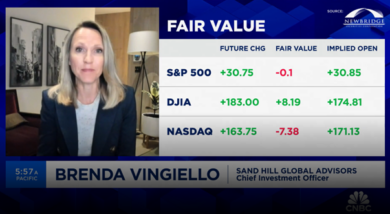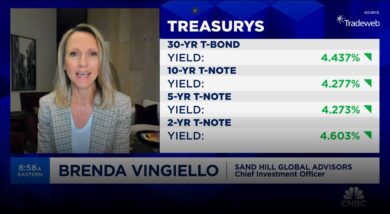Sand Hill's Chief Investment Officer, Brenda Vingiello, CFA, joins Jenny Harrington on “Halftime Report” to go over their most recent portfolio moves. Brenda's commentary begins

Mixed Signals
Investors have had a lot to be excited about thus far in 2017. With stocks reaching new all-time highs and longer-term interest rates trending lower, every asset class, with the exception of commodities, has delivered a positive return. However, two important markets – the U.S. stock market and the U.S. bond market – have begun to send very different, and contradictory, signals about what may lie ahead.
Historically, the stock market has exhibited significant strength in response to robust economic and corporate earnings growth. Interest rates usually respond by rising, causing bond market returns to weaken or even go negative. Conversely, when corporate earnings lag, stocks and interest rates generally decline and bonds post positive returns. This harmonious relationship has traditionally benefitted diversified investors by limiting volatility and providing opportunity to rebalance well allocated portfolios over time. More recently, however, these two markets appear to be at extreme odds with one another. The equity market has risen to new highs on the heels of the strongest first quarter earnings growth in over five years. Meanwhile, longer-term interest rates have fallen, implying the bond market feels the Federal Reserve’s plan to raise interest rates is too aggressive and unlikely to be enacted given the tepid inflationary environment. With such exaggerated views, do investors need to pick sides or could this simply be a miscommunication?
The answer most likely falls somewhere in between as economic growth in the U.S. continues to be somewhat muted and supply and demand for stocks and bonds has been greatly impacted by the actions of central banks around the world. This could be leading to some signals that aren’t necessarily being driven by fundamental views, but rather indicate a supply/demand imbalance as investors search for yield and a positive return.
The period since the Great Recession of 2007 through 2009 has been extraordinary. To support the global economy, central banks around the world purchased trillions of dollars of sovereign, corporate and mortgage bonds, driving interest rates to historic lows. The U.S. Federal Reserve was one of the first central banks to adopt this aggressive strategy, which resulted in the U.S. leading a global economic recovery that only recently began to gain traction in other parts of the world. At the time of this writing, the yield on a U.S. 10-year Treasury bond was 2.30%, a 10-year German bond was 0.46% and a Japanese 10-year bond was just 0.08%. With this global backdrop in mind, it is no wonder that demand for longer-dated U.S. Treasuries has remained high. This, in turn, has caused yields of longer-dated U.S. bonds to remain low, even as the Federal Reserve has raised short-term rates three times in the last twelve months.
Furthermore, there is another factor impacting interest rates. The Federal Reserve’s aggressive bond buying strategy resulted in its balance sheet growing from $869 billion in 2007 to $4.5 trillion today. As these bonds have naturally begun to mature, the Federal Reserve has been replacing them with new bonds rather than just letting the bonds mature and roll off their balance sheet. This buying activity has contributed to the low interest rate environment we are in today and may be further distorting the message the bond market appears to be sending. Recently, the Federal Reserve has begun to communicate a plan to gradually reduce its balance sheet. This may cause longer-term interest rates to rise modestly, thus changing the message in the coming year.
While it is true that the bond market has been notably impacted by the Federal Reserve, there may be some logic behind its cautious tone. Economic data in the U.S. softened during the first quarter of this year and inflation measures remain stubbornly low. Meanwhile, the job market and consumers have remained healthy and corporate earnings growth is poised to continue its strong growth path over the next several quarters. The equity market has chosen to focus solely on the positive factors to date and valuations have continued to expand. Stocks around the world are now trading above their ten-year average valuation levels. It is important to keep in mind that the last ten years include a period of dramatic earnings collapse during the financial crisis, as well as the more recent earnings crash within the energy sector, and these periods have had a notable impact on historical valuation figures. Nevertheless, we believe some caution is warranted and have begun to decrease general exposure to U.S. stocks in favor of stocks in other regions, such as Europe, that remain relatively inexpensive and are in the early stages of an economic recovery.
While many major market signals may be perplexing, most measures still point to a brighter future ahead. Despite the recent softness in the U.S., forward-looking economic data points suggest the global economy is continuing to recover and we expect this trend to progress over the balance of the year. This growth should continue to positively impact corporate earnings and thus be supportive of the equity market. However, returns are likely to be more heavily aligned with earnings growth than they have been over the last five years.
As the Federal Reserve’s balance sheet unwinding process begins, we expect longer term interest rates to catch up with short term rates. The end result may be a short period of more muted returns in fixed income. However, the Federal Reserve has been very cautious and measured thus far, and we don’t expect this to markedly change. Nevertheless, we have taken steps this year to reduce the exposure of your portfolio to rising interest rates. Higher interest rates will ultimately benefit investors and will also provide the Federal Reserve with more options when the current cycle comes to a close.
Lastly, financial markets seem to have given up hope that any meaningful pro-growth policies will be enacted in Washington. While this may certainly turn out to be true, at this point, any positive developments in this regard will likely be viewed as positive surprises. We are not counting on such activity, but we do recognize that it could prolong the current economic cycle and benefit investors in the intermediate term if financial markets were to respond favorably.
In our view, some of the recent market actions have created compelling investment opportunities. While it is impossible to predict when the stock and bond markets will begin to agree with one another again, it is likely their messages will become more aligned over time as global economic growth continues to progress and central banks become less accommodative.
Articles and Commentary
Information provided in written articles are for informational purposes only and should not be considered investment advice. There is a risk of loss from investments in securities, including the risk of loss of principal. The information contained herein reflects Sand Hill Global Advisors' (“SHGA”) views as of the date of publication. Such views are subject to change at any time without notice due to changes in market or economic conditions and may not necessarily come to pass. SHGA does not provide tax or legal advice. To the extent that any material herein concerns tax or legal matters, such information is not intended to be solely relied upon nor used for the purpose of making tax and/or legal decisions without first seeking independent advice from a tax and/or legal professional. SHGA has obtained the information provided herein from various third party sources believed to be reliable but such information is not guaranteed. Certain links in this site connect to other websites maintained by third parties over whom SHGA has no control. SHGA makes no representations as to the accuracy or any other aspect of information contained in other Web Sites. Any forward looking statements or forecasts are based on assumptions and actual results are expected to vary from any such statements or forecasts. No reliance should be placed on any such statements or forecasts when making any investment decision. SHGA is not responsible for the consequences of any decisions or actions taken as a result of information provided in this presentation and does not warrant or guarantee the accuracy or completeness of this information. No part of this material may be (i) copied, photocopied, or duplicated in any form, by any means, or (ii) redistributed without the prior written consent of SHGA.
Video Presentations
All video presentations discuss certain investment products and/or securities and are being provided for informational purposes only, and should not be considered, and is not, investment, financial planning, tax or legal advice; nor is it a recommendation to buy or sell any securities. Investing in securities involves varying degrees of risk, and there can be no assurance that any specific investment will be profitable or suitable for a particular client’s financial situation or risk tolerance. Past performance is not a guarantee of future returns. Individual performance results will vary. The opinions expressed in the video reflect Sand Hill Global Advisor’s (“SHGA”) or Brenda Vingiello’s (as applicable) views as of the date of the video. Such views are subject to change at any point without notice. Any comments, opinions, or recommendations made by any host or other guest not affiliated with SHGA in this video do not necessarily reflect the views of SHGA, and non-SHGA persons appearing in this video do not fall under the supervisory purview of SHGA. You should not treat any opinion expressed by SHGA or Ms. Vingiello as a specific inducement to make a particular investment or follow a particular strategy, but only as an expression of general opinion. Nothing presented herein is or is intended to constitute investment advice, and no investment decision should be made based solely on any information provided on this video. There is a risk of loss from an investment in securities, including the risk of loss of principal. Neither SHGA nor Ms. Vingiello guarantees any specific outcome or profit. Any forward-looking statements or forecasts contained in the video are based on assumptions and actual results may vary from any such statements or forecasts. SHGA or one of its employees may have a position in the securities discussed and may purchase or sell such securities from time to time. Some of the information in this video has been obtained from third party sources. While SHGA believes such third-party information is reliable, SHGA does not guarantee its accuracy, timeliness or completeness. SHGA encourages you to consult with a professional financial advisor prior to making any investment decision.
Other Posts By This Author
- – CNBC Halftime: Portfolio Moves | March 14, 2024
- – CNBC Squawk Box: Market Trends | March 6, 2024
- – CNBC Squawk Box: CPI Report | February 13, 2024
- – Getting Back to Normal
Related Posts







